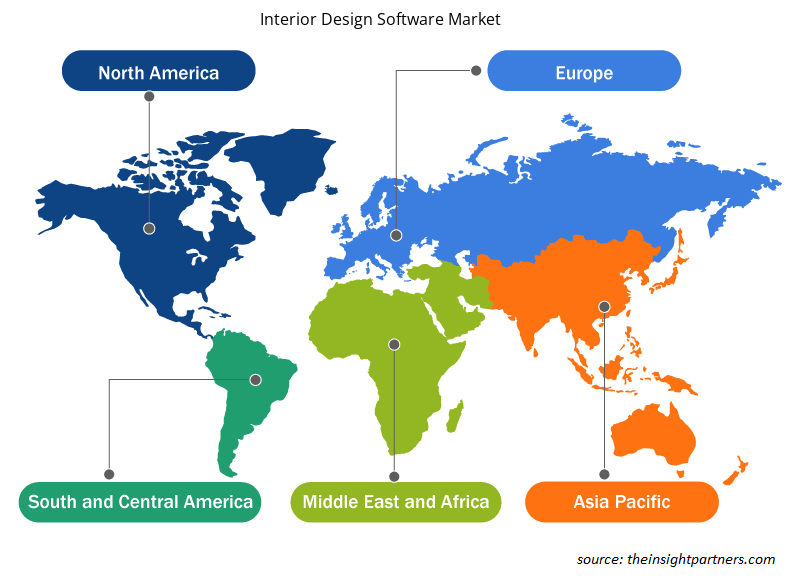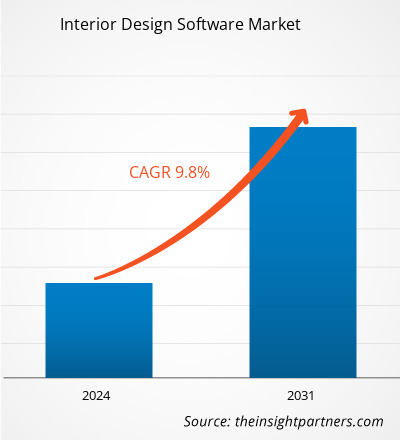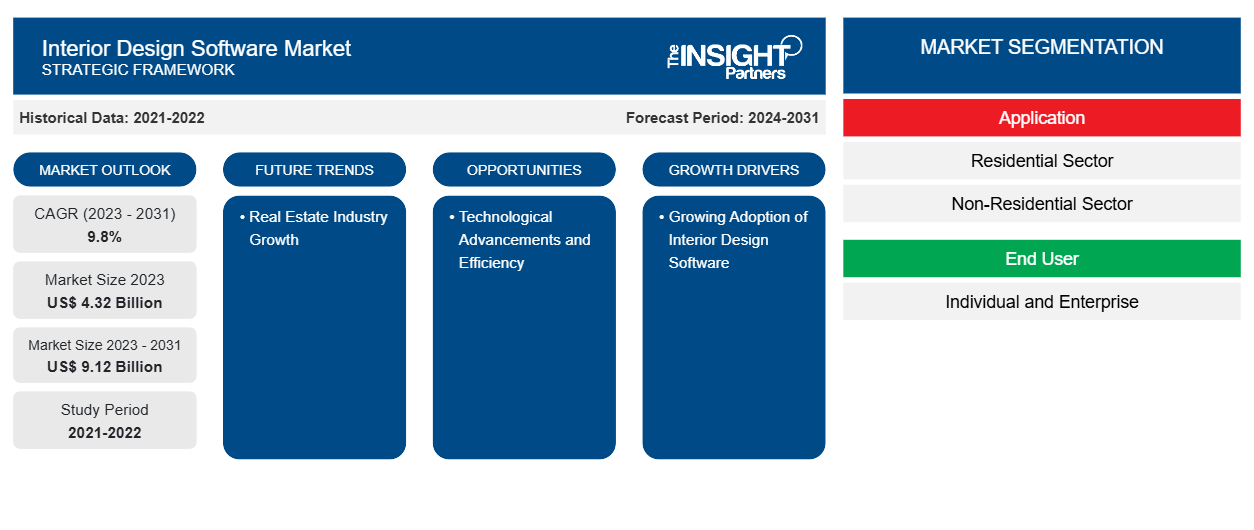インテリアデザインソフトウェアの市場規模は、2023年の43億2,000万米ドルから2031年には91億2,000万米ドルに達すると予測されています。市場は2023年から2031年の間に9.8%のCAGRを記録すると予想されています。不動産業界の成長は、引き続き市場の重要なトレンドとなると思われます。
インテリアデザインソフトウェア市場分析
生産性向上の需要の高まりは、この市場を牽引する主な要因の 1 つです。また、インテリア デザインと装飾の向上の需要の高まりと、クラウドベースのソフトウェアの使用の増加も、市場の成長を後押ししています。インテリア デザイン ソフトウェアに関連する相互運用性の問題により、この市場の成長が制限されています。さらに、仮想化プロセスの成長と、中国などの国で急速に成長しているインテリア デザイン ソフトウェアの需要により、市場にさまざまな機会がもたらされると予想されます。
インテリアデザインソフトウェア市場の概要
インテリア デザイン ソフトウェアを使用すると、建築家は内部環境の品質を早期に見積もることができます。また、建築家はこのソフトウェアを使用して、設計された建物が要求された基準から逸脱していないかを特定、追跡、測定することもできます。さらに、このソフトウェアを使用すると、建築家は予防措置を講じて改修や再構築の必要性を減らすことができます。また、窓、ドア、ベッド、テーブルのデザインなど、包括的なオプションも用意されており、デザイナーはこれを使用して部屋の正確なモデルを作成できます。
要件に合わせてレポートをカスタマイズする
このレポートの一部、国レベルの分析、Excelデータパックなど、あらゆるレポートを無料でカスタマイズできます。また、スタートアップや大学向けのお得なオファーや割引もご利用いただけます。
-
このレポートの主要な市場動向を入手してください。この無料サンプルには、市場動向から見積もりや予測に至るまでのデータ分析が含まれます。
インテリアデザインソフトウェア市場の推進要因と機会
インテリアデザインソフトウェアの採用拡大
インテリア デザイン ソフトウェア市場の主な成長要因は、建築家、エンジニア、請負業者によるこうしたソフトウェアの使用の増加です。このソフトウェアは、初期設計段階でインテリアを評価する際に大きく貢献しました。このソフトウェアは、エラーを減らし、効果的な時間管理を可能にし、提案されたデザインと実際の建設の違いを示し、フロア プラン、家具、インテリア装飾をリアルな 3 次元環境に設定することで、作業の全体的な効率と精度を高めます。
技術の進歩と効率
世界的な建設活動の急増は、運用効率の改善をもたらしたインテリア デザイン ソフトウェアの広範な採用と同時に起こり、インテリア デザイン サービス部門の成長を著しく加速させました。この傾向は、このソフトウェアが設計プロセスをスピードアップし、時間とコストを節約し、デザイナーが正確でリアルな部屋のモデルを作成できる幅広い家具の選択肢を提供する機能によってさらに強化されています。このように、インテリア デザイン ソフトウェアの統合が進むことは、運用を楽にするだけでなく、市場の絶対的な成長にも貢献しています。
インテリアデザインソフトウェア市場レポートのセグメンテーション分析
インテリア デザイン ソフトウェア市場分析の導出に貢献した主要なセグメントは、アプリケーションとエンド ユーザーです。
- 用途に基づいて、市場は住宅部門と非住宅部門に分かれています。住宅部門セグメントは2023年に大きな市場シェアを占めました。
- エンドユーザーに基づいて、市場は個人と企業に分割されています。企業セグメントは2023年に大きな市場シェアを占めました。
インテリアデザインソフトウェアの地域別市場シェア分析
インテリアデザインソフトウェア市場レポートの地理的範囲は、主に北米、アジア太平洋、ヨーロッパ、中東およびアフリカ、南米および中米の 5 つの地域に分かれています。
インテリアデザインソフトウェア市場の地域別概要では、さまざまな地域で大きな成長機会が明らかになっています。アジア太平洋地域では、特に東京、北京、ムンバイなどの大都市での人口増加と都市化により、中国の国家開発戦略などの取り組みにより、住宅部門への注目が高まっています。さらに、中国やインドなどの国での建築インフラ計画の増加、北京、東京、ムンバイなどの大都市での都市化と人口増加により、アジア太平洋地域は予測期間中に市場で最も高いCAGRを記録すると予測されています。
インテリアデザインソフトウェア市場の地域別分析
予測期間を通じてインテリア デザイン ソフトウェア市場に影響を与える地域的な傾向と要因は、Insight Partners のアナリストによって徹底的に説明されています。このセクションでは、北米、ヨーロッパ、アジア太平洋、中東、アフリカ、南米、中米にわたるインテリア デザイン ソフトウェア市場のセグメントと地理についても説明します。

- インテリアデザインソフトウェア市場の地域別データを入手
インテリアデザインソフトウェア市場レポートの範囲
| レポート属性 | 詳細 |
|---|---|
| 2023年の市場規模 | 43.2億米ドル |
| 2031年までの市場規模 | 91.2億米ドル |
| 世界のCAGR(2023年~2031年) | 9.8% |
| 履歴データ | 2021-2022 |
| 予測期間 | 2024-2031 |
| 対象セグメント |
アプリケーション別
|
| 対象地域と国 |
北米
|
| 市場リーダーと主要企業プロフィール |
|
インテリアデザインソフトウェア市場のプレーヤー密度:ビジネスダイナミクスへの影響を理解する
インテリア デザイン ソフトウェア市場は、消費者の嗜好の変化、技術の進歩、製品の利点に対する認識の高まりなどの要因により、エンド ユーザーの需要が高まり、急速に成長しています。需要が高まるにつれて、企業は提供内容を拡大し、消費者のニーズを満たすために革新し、新たなトレンドを活用し、市場の成長をさらに促進しています。
市場プレーヤー密度とは、特定の市場または業界内で活動している企業または会社の分布を指します。これは、特定の市場スペースに、その市場規模または総市場価値に対してどれだけの競合相手 (市場プレーヤー) が存在するかを示します。
インテリアデザインソフトウェア市場で事業を展開している主要企業は次のとおりです。
- オートデスク株式会社
- 株式会社チーフアーキテクト
- ダッソー・システムズ
- ECDESIGNスウェーデンAB
- ルームスケッチャーAS
- ルームトドOU
免責事項:上記の企業は、特定の順序でランク付けされていません。

- インテリアデザインソフトウェア市場のトップキープレーヤーの概要を入手
インテリアデザインソフトウェア市場のニュースと最近の動向
インテリア デザイン ソフトウェア市場は、主要な企業出版物、協会データ、データベースなどの一次調査と二次調査を経て定性的および定量的データを収集することで評価されます。インテリア デザイン ソフトウェア市場の動向のいくつかを以下に示します。
- IKEA US は、手頃な価格でプロフェッショナルによるマンツーマンのインテリア デザインを提供するまったく新しいプログラム、IKEA インテリア デザイン サービスの開始を発表しました。消費者と企業は、専門家とつながり、クリエイティブなソリューションであらゆる空間をデザインする機会が得られます。
(出典:Inter IKEA Systems BV、企業ウェブサイト、2023年4月)
- IKEA 最大の小売業者である Ingka Group は本日、AI を活用した新しいデジタル デザイン エクスペリエンスである IKEA Kreativ を発表しました。この直感的な新しいエクスペリエンスにより、お客様はコンピューターやスマートフォンから自分の生活空間をデザインし、視覚化できる、初めてリアルで完全に統合された方法を利用できるようになります。
(出典:Inter IKEA Systems BV、企業ウェブサイト、2022年7月)
インテリアデザインソフトウェア市場レポートの対象範囲と成果物
「インテリアデザインソフトウェア市場の規模と予測(2021〜2031年)」レポートでは、以下の分野をカバーする市場の詳細な分析を提供しています。
- インテリアデザインソフトウェア市場の規模と予測(対象範囲に含まれるすべての主要市場セグメントの世界、地域、国レベル)
- インテリアデザインソフトウェア市場の動向、および推進要因、制約、主要な機会などの市場動向
- 詳細なPEST/ポーターの5つの力とSWOT分析
- 主要な市場動向、世界および地域の枠組み、主要プレーヤー、規制、最近の市場動向を網羅したインテリアデザインソフトウェア市場分析
- 市場集中、ヒートマップ分析、主要プレーヤー、インテリアデザインソフトウェア市場の最近の動向を網羅した業界の状況と競争分析
- 詳細な企業プロフィール
- 過去2年間の分析、基準年、CAGRによる予測(7年間)
- PEST分析とSWOT分析
- 市場規模価値/数量 - 世界、地域、国
- 業界と競争環境
- Excel データセット
最新レポート
関連レポート
お客様の声
購入理由
- 情報に基づいた意思決定
- 市場動向の理解
- 競合分析
- 顧客インサイト
- 市場予測
- リスク軽減
- 戦略計画
- 投資の正当性
- 新興市場の特定
- マーケティング戦略の強化
- 業務効率の向上
- 規制動向への対応























 無料サンプルを入手 - インテリアデザインソフトウェア市場
無料サンプルを入手 - インテリアデザインソフトウェア市場